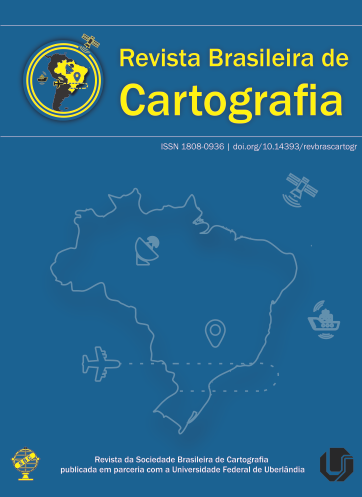Contribution for the Determination of Geoid-Quasigeoid Separation (GQS) in Brazilian Territory
Main Article Content
Abstract
The geoid and quasi-geoid separation, understood as the difference between normal and orthometric heights, can be in order of centimeters, reaching meters in great height variation areas, being related to the density of topographic lithological masses and resolution of the elevation model used. In this context, the main objective of this research was evaluate the GQS in Brazil, using four different methodologies. The first calculated GQS by the difference between normal and orthometric heights. The second employed the simplified Bouguer anomaly. The third introduced the terrain correction and the fourth added the gravimetric correction. The study was developed using height and gravimetric data provided by IBGE, height data from SRTM with 3” resolution and the variable density map derived from the geological map of Brazil. The GQS obtained through the first and second methodologies did not present significant differences. The simplified Bouguer anomaly corresponded, on average, about 92.5% of the total GQS in Brazil. By Introducing the terrain and gravimetric corrections, appears that the combination of these corresponded to 7.5% of the GQS, being the largest contribution in the southern region, confirming that these corrections should not be neglected, especially in regions with higher variation heights. The variable density model differed about 4.7% from the constant density model, with this difference being greater in the Midwest region. The main contribution of this research, was the feasibility of incorporating the variable density model and topographic and gravimetric corrections in the calculation of GQS nationwide.
Downloads
Metrics
Article Details

This work is licensed under a Creative Commons Attribution 3.0 Unported License.
Authors who publish in this journal agree to the following terms:
- Authors retain copyright and grant the journal right of first publication with the work simultaneously licensed under a Creative Commons Attribution License that allows others to share the work with an acknowledgment of the work's authorship and initial publication in this journal.
- Authors can enter into separate, additional contractual arrangements for the non-exclusive distribution of the journal's published version of the work (e.g., post it to an institutional repository or publish it in a book), with an acknowledgment of its initial publication in this journal.
- Authors are permitted and encouraged to post their work online (e.g., in institutional repositories or on their website) before and during the submission process, as it can lead to productive exchanges, as well as earlier and greater citation of published work (see "The Effect of Open Access").





